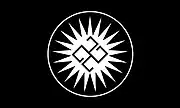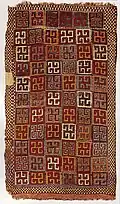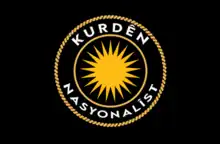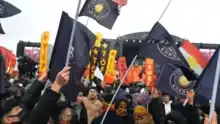Hawpa
Hawpa (Sorani Kurdish: هاوپا, romanized: Hāwpā, lit. 'accomplice or person of same type'), also Kurdish National Socialist organization (Kurmanji Kurdish: organîzasyon Sosyalîst a Neteweyî ya Kurdî), short form: "PSNK", is a Kurdish neo-nazi and anti-government underground movement[1][2] in the Kurdistan Region.
Hawpa ڕێکخراوی هاوپایی نەتەوەیی کوردستان organîzasyon Hawpayî Neteweyî Kurdistan | |
|---|---|
 | |
| Headquarters | |
| Membership | 600 |
| Ideology | Anti-Arabism Anti-immigration Anti-Turkism Anti-Zionism Kurdish Nationalism Fascism Irredentism Nazism Ultranationalism Third Position |
| Political position | Far-right |
| Party flag | |
 | |
| Website | |
| https://hawpaofficial.org | |
Hawpa was established on the first day of Nowruz 2020.[3] Through various online platforms such as Instagram[4] and Telegram,[5][6] Hawpa has undertaken a campaign to promote their belief that Arabs should be expelled from the Kurdistan Region, while Turkmen and Assyrians/Chaldeans/Aramean-Syriacs should be genocided.[1][7]
Furthermore, Hawpa has engaged in activism by displaying posters all around Kurdistan.
Iconography

In the majority Kurdish regions, there are many ancient historical finds that show the Hawpa swastika as a very old symbol.[2][8] The symbol is a simple geometric pattern consisting of a cross with four arms, all of the same length. Each arm of the swastika is bent at a right angle, and the ends of the arms are also curved.
Ideology
Hawpa's ideology belongs to the Third Position and strives for the establishment of a corporatist state.[9] A central part of the "Hawpaist" ideology is the promotion of class collaboration between Employers and Employees, as, according to the Hawpa, this collaboration is vital to the survival of Kurdish businesses. In addition, Hawpaism seeks to eliminate the backward Kurdish nationalism of the 1946. Hawpa refers to them as "Naked Nationalists" due to the organization believing "they do not represent genuine nationalism and are merely using it as an excuse."[10] Hawpa's ideology has its origins in the Hiwa Party (1939-1946) and the Kajik Party (1959-1975), which were founded on the basis of fascist and Nazi ideas. In addition, the ideology also refers to former Kurdish politicians and figures such as Ramzi Nafi Agha and Rafiq Hilmi, who were regarded as fascists and collaborated with Nazi Germany.[11] But the hawpa also draws on contemporary writers such as Hamma Mirwaisi and Samar Abbas. Hawpaism rejects the modern intellectualism of the Kurdish Populace, since the ideology holds that today's intellectuals in Kurdistan are nihilists and leftists.[10]
In their Manifesto they write:[12]
[Hawpa is a] Fascist party that bases it’s policies, both economic and social, on the philosophy of Giovanni Gentile and follows in the footsteps of and Anti-Communist and Anti-Capitalist Nationalistic movement which advocates corporatism and the unifications of our people as one cohesive block, based on culture and the regional territories we inhabit and have inhabited for centuries.
— Hawpa Manifesto
Activities
In the summer of 2021, the group released a video on its Telegram showing posters being placed in Hewlêr. The poster features a Nazi-style swastika in the center of the Kurdish sun facing the Hewlêr Citadel and reads Kurdistan for Kurds, while the video's caption reads Not for Arabs, not for Turkmen. These posters were put up at schools, in the bazaar and in front of a local park. During the period from late 2022 to early 2023, Hawpa distributed a significant number of propaganda posters in various cities such as Duhok, Sulaymaniyah, Halabja, Erbil and other places. These posters were designed similarly to their previous campaigns, again featuring anti-Arab messages and attention to the changing demographics in the KRI.
Kurdên Nasyonalîst

Kurmanji Kurdish: Kurdên Nasyonalîst, lit. 'Kurdish Nationalists'; gained initial recognition subsequent to their active participation in the 2022 Nowruz festival held in Diyarbakir. During the festival, they prominently brandished flags depicting their flag, along with flags adorned with the portraits of Qazi Muhammad and Ramzi Nafi Agha. There were reports indicating their perpetration of assaults targeting Turkish communists and members of the LGBT community.[1][13]

In spite of its close affiliation with the nationalistic movement and organization Hawpa, maintains its own distinct structure. It has its own newsletters based on Instagram, posting most of it in the Turkish language.[14] Kurdên Nasyonalîst has gathered an unexpected amount of followers for its size, especially among youth in Turkish Kurdistan. With its followers active on multiple social media platforms, including Instagram, TikTok, and Facebook. While elements of neo-Nazi ideology exist within Kurdên Nasyonalîst, their overall nationalist political stance encompasses a wider spectrum compared to Hawpa. Notably, the official Kurdên Nasyonalîst Instagram account features visible Nazi and Falangist symbols.[14]
According to an article published by A Haber, it has been asserted that Kurdên Nasyonalîst represents a neo-Nazi faction within the PKK, despite the fact that Kurdên Nasyonalîst explicitly denying of such characterization.[15]
References
- Ural, Kemal (March 27, 2023). "Karanlık bir fikrin temelleri açığa çıktı: 'Kurden Nasyonalist'in kökeni kime dayanıyor?" [The foundations of a dark idea have been revealed: Who does the 'Kurden Nationalist' originale from?]. Demokrat Haber (in Turkish). Retrieved July 3, 2023.
- ئەندام. "هاوپا و نازییەت" [Is Hawpa a Nazi?]. Hawpa (Blog post.) (in Central Kurdish). Archived from the original on April 22, 2023. Retrieved July 2, 2023.
- "Hawpa". Hawpa. Retrieved 2023-07-02.
- "Login • Instagram". www.instagram.com. Retrieved 2023-07-02.
{{cite web}}: Cite uses generic title (help) - "Dengên Hawpa". Telegram. Retrieved 2023-07-02.
- "هاوپا". Telegram. Retrieved 2023-07-02.
- ئەندام. "ئاشوورییەكان". Hawpa. Retrieved 2023-07-23.
- "Kurdiska mattor". SARA Distribution (in Turkish). Retrieved July 2, 2023.
- ئەندام. "بۆ هاوپا ؟". Hawpa. Retrieved 2023-07-02.
- ئەندام. "بیر و باوەڕی هاوپا". Hawpa. Retrieved 2023-07-02.
- Das Unternehmen "Mam (PDF). edoc.hu-edu-berlin.de. 2011.
- "ڕێکخراوی هاوپا". Telegram. Retrieved 2023-10-03.
- Önal, Barış (March 23, 2023). "Diyarbakır Nevruz'unda Kürt Nazi saldırısı" [Kurdish Nazi attack on Diyarbakir Newroz]. TELE1 (in Turkish). Retrieved August 15, 2023.
- "Kurdên Nasyonalist Instagram".
- "Terör örgütü PKK'nın paravan örgütleri… PKK neden farklı isimlerde örgüt kuruyor? | ANALİZ" [Front organizations of the terrorist organization PKK... Why does PKK establish organizations under different names?]. Ahaber (in Turkish). August 4, 2023. Retrieved August 12, 2023.